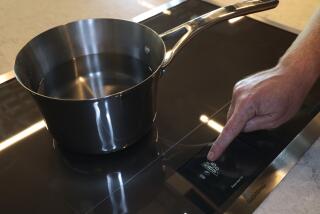A New Generation of Small Gas Heaters
- Share via
QUESTION: Our family room gets chilly, and I am considering installing a small gas heater. It must be quiet and safe with my children around. What heater design and features are best and most efficient?
ANSWER: Installing a small high-efficiency (up to 84%) heater is a good idea. Not only are the new ones quiet and efficient, but several models have hand-held remote controls (like your TV’s) for the ultimate convenience. These are very high-quality, stylish units with up to 10-year warranties.
Although there are many designs to choose from, direct-vent models with sealed combustion are the safest and quietest. Since these use no room air for combustion, chilly drafts are minimized. With sealed combustion, the burner noises are also isolated from your room.
Another advantage of a direct-vent gas heater is that it vents outdoors through the wall (no expensive chimney). Most models require only a 3-inch diameter hole in an outside wall behind the heater. Both the inlet air and flue gases flow through a single concentric double-walled vent.
A small heater, adequate to take the chill off your family room in the evening, costs less than $1 per day to operate. In fact, you may be able to set your furnace thermostat lower and save money overall.
If your area has electrical power outages at times, select a model that generates its own millivolt electricity to power the electronics. It can protect your house from freezing and expensive damage. Remember, your central gas furnace will not operate when the electricity is off.
For the best comfort, spend a little extra for a top-of-the-line heater. These have built-in humidifiers, seven-level heat output/fan speeds, air filters and economy modes. In the economy mode, the thermostat setting gradually lowers several degrees so the temperature change is not noticeable.
For the easiest installation, select a small, window-mounted gas heater (can also be mounted through the wall). The combustion chamber is totally sealed from indoors, and you can replace it with an air conditioner in the summer.
One of the newest types of gas heater for 1998 is a direct-vent fireplace with a built-in air conditioner. The small, powerful 8,000-BTU air conditioner is hidden in the hearth section below the fireplace.
If your room is large or very chilly, consider a wall furnace. Select a counterflow model so that the warm air blows out near the floor. An in-the-floor gravity model is also a good choice and quiet (no blower needed). To view the flames, choose a no-blower radiant model with a glass front.
Write for (or instantly download at https://www.dulley.com) Update Bulletin No. 454, a buyer’s guide to 20 high-efficiency direct-vent gas heater-fireplace models, efficiencies, sizes, comfort features and sizing/cost-to-use charts. Please include $3 and a business-size, self-addressed envelope; mail to James Dulley, Los Angeles Times, 6906 Royalgreen Drive, Cincinnati, OH 45244.
Sun and Moisture Can Mar House Trimming
Q: The wooden trim on the side of our house is exposed to the sun and does not hold up very long. Do you have any tips on what I can do when I fix it this time to make it last longer?
A: I would guess that the sun alone is not causing the problem with the wooden trim. Moisture is probably getting into the wood. This, plus the temperature changes from the hot sun to the cold nights, causes problems.
You can extend the life of the trim by painting the end-grain saw cuts as you install the trim. These open-grain splices are often not sealed as the trim is being fitted together. Just use a paint pad to saturate those ends.
Letters and questions to James Dulley, a Cincinnati-based engineering consultant, may be sent to James Dulley, Los Angeles Times, 6906 Royalgreen Drive, Cincinnati, OH 45244.


